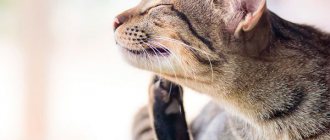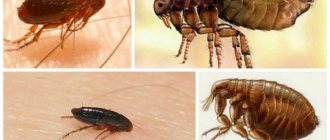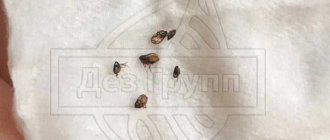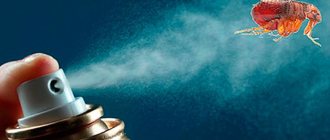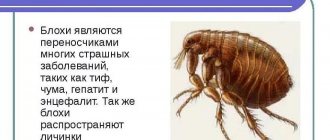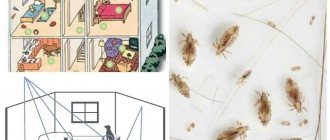SONY DSC
Reproduction of parasites is a process that a person needs to take into account when fighting fleas. Statistics show: most often this process occurs in places where cats or dogs live. Earth, cat and other flea species reproduce and develop very quickly - all stages of development take several weeks in practice. These pests belong to the types characterized by complete transformation. Scientists point to good survival rates of insects and their larvae.
Flea reproduction - description of the process of flea reproduction
Interestingly, the reproduction of fleas has nothing to do with their habitat - cats, dogs or humans. Insects may only need blood from people and their pets. The description of this species says that the female is ready to mate fairly soon after it emerges from the pupa. Mating takes place either on the cat or in some kind of shelter. The cycle can only begin after the female feasts on blood after mating. Translucent larvae emerge from the eggs. In their final stage they can reach 5 mm in length. After four weeks, the larva entangles itself in a cocoon and begins to transform into a pupa. The pupal stage can last from five days to a whole year.
Flea development process
As soon as the female fleas leave the pupa, they immediately begin to mate. This happens anywhere - in the bedding of animals, on their bodies, in the carpet, near cat litter boxes - where two individuals of different sexes could find each other. After the long-awaited reunion, the female only needs to drink someone's blood for the egg development process to begin.
Fleas lay eggs where animals most often spend their free time. However, there have been cases when eggs were laid directly on the fur of pets, after which they simply crumbled onto the floor in an apartment or house.
The process of egg maturation occurs directly in the flea’s body, in batches of four to five at a time, depending on the frequency of feeding. When the eggs mature, the flea literally shoots them out of its body in any place convenient for it. After which they are scattered over a long distance. This is mainly due to the fact that in this situation it will be easier for newborn fleas to feed themselves and avoid the struggle for existence between other individuals.
How do fleas reproduce in cats?
In cats, they reproduce using larvae. They appear less often on the body of animals, but on the bedding or near the toilet - quite often. They can lay about eight eggs at a time. During their lifetime, at the expense of cats and kittens, parasites can lay about 500 eggs. After reproduction, you can notice larvae that resemble small worms. From the very beginning of life, they feed on waste from adults. With normal nutrition, they begin to molt. Three molts mean the appearance of an adult insect.
How do earth fleas reproduce?
There are practically no peculiarities in how earthen species reproduce from the generally accepted process for this insect. During the mating process, 10 to 30 eggs are laid. Since these are earth parasites, they lay their eggs directly on the ground, not far from the plant. This plant, as a rule, becomes a source of food for the larva. This stage takes 2-4 weeks. Next, the larva pupates, and within a week the formation of an adult earthen individual occurs.
How do fleas reproduce in humans - can fleas from animals pass to humans?
In fact, parasites can transfer to the human body only in order to bite and feed on blood. They cannot live on a person, much less reproduce on him. If a person finds an adult or its larva in his hair, then this is nothing more than an accident, because parasites are looking for sufficiently secluded places to procreate. In this sense, these insects should not be confused with lice, which can both live and reproduce on the human body.
Flea breeding period and speed
If you study a simple description of the breeding period, it looks like this: egg - larva - pupa - flea. Compared to other insects, the reproduction process in these insects is very fast. If certain conditions are right, the process from egg to fully developed adult can take ten days. Thus, the change of generations in these parasites can take a little more than one week. Most often this process takes three to four weeks. It is believed that a warm apartment is a favorable place for parasites to multiply quickly.
Peculiarities of reproduction of various types of fleas
The dog, cat and human fleas parasitize mammals. They are very similar in structure and reproduce in a similar way. The time and conditions for the development of all stages of the cycles differ slightly. The same cannot be said about the chicken flea.
The chicken flea prefers to settle on birds, since it has a weaker piercing-sucking mouthparts. Also, unlike other species listed above, this parasite does not remain on the host’s body for a long time. She spends most of her time in his nest, that is, in the chicken coop. The flea jumps onto the host's body for a short time to feed.
Before laying eggs, a chicken flea needs to visit the host's body several times. That is, she needs several meals, unlike dog, cat and human fleas, which only need one.
In general, all types of fleas that humans encounter reproduce in the same way. Knowing how to deal with one species should be enough.
How to get rid of fleas in the house and on your pet
The fight against fleas in cats must have a comprehensive approach. If you notice that your pet has begun to itch, then it’s time to use an anti-flea collar, which is usually impregnated with effective insecticides. One of the most popular is the Maximum collar, which works for two months. A popular option is drops on the withers. For example, drops from the manufacturer Bars just need to be dropped onto the body at several points, after which the parasites will be removed.
The remedies for fleas in dogs are similar. There are also Maximum or Hartz collars for them, as well as drops called Bars. Also popular are Frontline spray, which is used to treat your pet’s fur, and RolfClub shampoo without the slightest side effects.
Source
Anatomical features of fleas
The flea is a special parasite that lives on a warm-blooded “host” and feeds on his blood not only for reproduction, but throughout adult life, and both males and females feed exclusively on blood. Therefore, the anatomy of the insect is fully consistent with these “tasks”.
Of the currently known more than 2000 species, only a few varieties pose a threat to humans, their environment and the economy. These are parasites whose “hosts” are rodents, birds, dogs and cats, other domestic animals, and livestock. As well as domestic fleas, whose eggs and larvae can be laid directly in a human home.
Externally, the pests look very flattened, mostly brown in various shades, insects without wings.
- The body does not exceed 5 mm in length; in the female, during the period of hatching eggs, it can increase to 10 mm.
- The parasite is covered with many tiny spines and bristles.
- It has 3 pairs of limbs covered with bristles, the front - the shortest - clings, the middle - auxiliary - holds, the back - the longest - pushes off to make jumps.
- The organ for piercing the skin and sucking blood is a superbly developed piercing and sucking apparatus.
- There are hidden antennas on the head, which the males put forward during mating and hold the female with them during the mating process.
- At the back there is a special organ that, with the help of hairs, captures even minor vibrations of air, which is called the pygidium.
This anatomy allows the pest to quickly and easily move through wool, hair, down and feathers, between the wings of birds and the folds of skin in animals. In addition, the flea freely clings and moves, changing the angle and direction as desired, on clothing, and jumps into shoes.
The parasite settles in nests, burrows, booths, as well as in people’s homes - in carpets, furniture, bedding and other hard-to-reach places. Soon, if favorable conditions exist, intensive reproduction of fleas begins to occur there.
Parasite development: from larva to adult
The cat flea (mature individual) is a small insect about 5 - 6 mm, dark brown in color with a shine. The body of the flea has a laterally flattened shape and is covered with multiple spines and irregularities. This structure helps the insect move in thick fur. The three pairs of limbs differ in size. The longest is the third pair, designed for long-distance insect jumps.
Stages of flea development
| 4 stages of flea development | Characteristic | Photo |
| Egg stage | Flea eggs are very small, do not have a sticky surface, so they are practically not retained in the animal’s fur, but fall off. The eggs' favorite places are cracks in the floor, the space behind baseboards, furniture, and carpet fibers. Under comfortable conditions, egg development occurs within a few days. Under unfavorable environmental conditions (low temperature, drought, etc.), development slows down | Flea eggs, male and female |
| Larval stage | From the egg, worm-like larvae develop, feeding on the remains of organic substances (excrement of adults, dead epidermis, etc.). This stage of the flea feels great in cracks between floors and furniture, in old clothes, rags, etc. As it develops, the size of the larva increases, reaching 4 - 5 mm. After about 3 - 4 weeks, the flea larva pupates | |
| Pupa cycle | The pupated larva is one of the most tenacious stages of the cat flea. Under favorable conditions, an adult can emerge from a pupa within 7 to 10 days. If the pupa is in unfavorable external conditions, the process of development of an adult can take up to one year. Thanks to the presence of special receptors on the surface of the cocoon, the pupa determines the onset of optimal conditions for the emergence of an adult flea. From the point of view of combating blood-sucking insects indoors, the pupal stage is the most unproductive. It is practically unaffected by disinfectant solutions in normal concentrations. At the pupal stage, the flea population is capable of overwintering | Cat flea pupae in the cracks between floorboards |
| Imago (adult) stage | An adult individual emerges from the pupa under favorable conditions and seeks food for itself. Both male and female individuals bite their owners and feed on blood. Fleas are characterized by species specialization, so cat fleas look for a cat for food, and canine fleas look for a dog. Cats and dogs, and often people too, are just food for fleas. And the development cycle of insects occurs outside the body of a living organism |
Mating of fleas occurs in different places (bedding, the animal’s body, the pet’s favorite places, etc.). Therefore, it is not entirely correct to say that fleas reproduce only on animals. For the eggs to develop, the female must drink blood from the owner at least once. When they mature, the female literally shoots them onto surrounding objects.
Features of biological development and high adaptability to environmental conditions make cat fleas one of the most common parasites. Sometimes it’s hard to even imagine how many fleas a cat can have. It is believed that when an animal is massively affected, about 200 adult individuals can live on it at the same time.
How long can fleas live?
The imago or adult insect is characterized by its own characteristics of life activity. Adults live up to two months in warm conditions. On
this ends their life cycle. But they are also capable of hibernating if conditions are not suitable for them or there is no food for a long time. A few months later, with absolutely no harm to health, fleas go hunting. Fleas can live without food for months, maintaining mobility, but they will not be able to reproduce during this period. Flea disinsection is a reliable way to solve the problem!
Flea pupa
The pupa is the last stage before the adult. An adult flea may emerge from the cocoon in as little as 3-5 days, or may remain in the cocoon for a year or more, waiting for the right time to emerge.
When is the right time? Stimuli such as high ambient temperature, high humidity, even vibrations and carbon dioxide emanating from a passing animal will cause the flea to emerge from the cocoon faster. This brings us back to the adult flea.
The entire life cycle is very diverse, as evidenced by the variability at each stage of development. As mentioned above, the cycle can range from two weeks to two years. This is why it is so important to remain vigilant even if your flea problem is thought to be under control!
Adult flea
The adult flea is very flat from side to side. Fleas have hair-like bristles on their bodies and legs that help them navigate pets' fur.
Fleas have 3 pairs of legs, the back pair is designed for jumping. Fleas are well known for their jumping ability.
Adult fleas prefer to live on animals and rarely leave their host voluntarily. Their diet consists of blood food, courtesy of their host animal.
The female flea lays white, round eggs. An adult female flea can lay up to 50 eggs per day1, and 500-600 eggs2 over several months.

